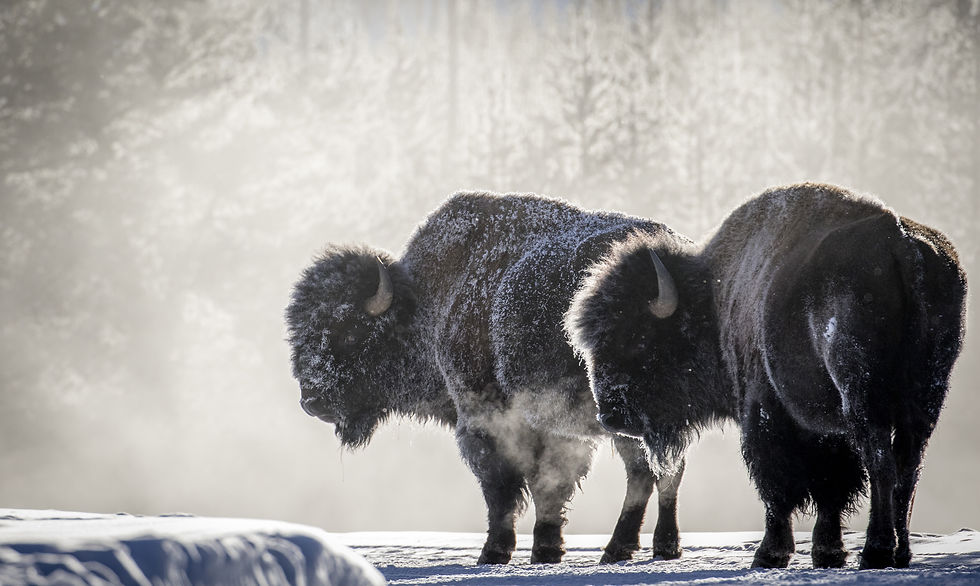Climate Change in Yellowstone: Understanding the Home on the Range
- Heather McKee

- Jul 8, 2020
- 4 min read
Updated: Jan 9, 2023

Fluttering grasslands stretching to the horizon, steaming mudpots and cauldrons, thundering bison, wolves howling through blizzards—Yellowstone is wild. America’s first national park, created nearly 150 years ago, is known as the only remaining intact ecosystem in the lower forty-eight. The park contains some of the only remnants of early American grasslands, as well as our collective nostalgia for our country’s wild past.
The truth is that humans have dramatically affected the park’s ecosystems through that entire time. Long before the park’s creation, Native American tribes lived, hunted, and ceremonially gathered in the region (Kiowa, Blackfeet, Cayuse, Coeur d’Alene, Bannock, Nez Perce, Shoshone, and Umatilla, among others) and affected the ecosystem in subtler ways.
Ironically, the early days of the national park saw the extirpation of predators large and small, from cougars and wolves, to bobcats and skunks. Tourism traffic brought disease and pollution. However, efforts to restore the park’s bison populations began around the turn of the 19th Century, and more recently, the park has worked on projects like the reintroduction of wolves to mend some the broken pieces of the ecosystem.
THE LARGEST HUMAN IMPACT ON YELLOWSTONE NATIONAL PARK HAS ONLY JUST BEGUN, HOWEVER. HOW WILL CLIMATE CHANGE AFFECT THE GREATER YELLOWSTONE ECOSYSTEM?

Climate models for Yellowstone forecast more volatile fire seasons, higher temperatures, shorter winters, and less snowfall. Already, Yellowstone has 30 fewer days of snow cover per year than 50 years ago. What do these climatic changes mean for grassland composition, bison populations and migrations, and wetland creatures? And what does all that mean for park management policies?
Ecology Project International Yellowstone Wildlife and Yellowstone Winter Ecology students have been working with researchers in the Greater Yellowstone Ecosystem for years to collect data on the Greater Yellowstone Ecosystem. EPI students work with the park’s bison team on their “Home on the Range” study in summer and winter to understand how bison share changing grassland resources with other ungulates in the park. The iconic bison’s diet is mostly grass—grass that loses protein after successive hot and dry years.
In order to collect data on the bison, the students first have to find them. EPI students use telemetry equipment to locate radio-collared individuals in the park. They record the size of the group the individual is part of, as well as collect demographic information about the group. Students then collect fecal samples for researchers to analyze the bison’s diet. In the winter, students also measure and record snow pack. Last year, EPI Yellowstone students contributed 2,174 hours of tracking and data collection to the “Home on the Range” study!

Most of these students are local to the Yellowstone area, growing up with diverse viewpoints on how the park should be managed. EPI courses give students a first-hand look at the biological research behind park policy and offer them the opportunity to discuss a variety of perspectives on complicated wildlife management issues. One local Yellowstone student said of his experience, “I used to stick to my own opinions about wolves, but I’ve realized there are so many ideas out there…and you have to find a way to work with them. My EPI course reminded me that I wanted to work in Yellowstone as a biologist, or with Montana Fish, Wildlife, and Parks.” He’s not alone in believing his EPI course helped him expand his perspective. In fact, post-course surveys show that EPI Yellowstone Wildlife Ecology students, on average, increase their understanding of the complexities of wolf management by 30%.
Although EPI courses focus on the Greater Yellowstone Ecosystem’s grasslands, wetlands contribute great biodiversity to the ecosystem and provide critical habitat to species ranging from moose to sandhill cranes. Climate change will be especially arduous for those creatures that live, breed, or feed in wetland areas. Last year, EPI students contributed 271 hours to Custer Gallatin National Forest Service projects to create baseline population studies of four amphibians in the Yellowstone area: the Columbia spotted frog, boreal chorus frog, tiger salamander, and western toad, a species of concern in Montana.
EPI Yellowstone students also contribute sweat equity to preserving native ecosystems through service projects. Last year, Yellowstone students spent 375 hours removing fencing to open up routes for pronghorn migration, replant native grasses in degraded grasslands, and remove mountains of invasive plant species.
The data collected by EPI students on all these projects—from tracking ungulates to counting frogs—helps inform Yellowstone National Park and USFS wildlife management policies. The data also illustrate a picture of how the animals and plants at this singular place are changing along with the climate, and how policies might need to change to protect them.
One bison researcher summarized the importance of data collection in a Nature Conservancy article, “Unfortunately, we are running out of time. We need to collect a lot more poop from a lot more bison if we are going to have a broad enough understanding of bison diet to stave off some of the effects of warming. We not only want to keep bison on the prairie, but also massive bison – the kind that make the earth shake when they run by.”
You can support service projects and data collection by EPI Yellowstone Winter Ecology and Wildlife Ecology students, and the conservation policy this data informs, by donating to Ecology Project International here.


